Recent Progress in Solution Structure Studies of Photosynthetic Proteins Using Small-Angle Scattering Methods
Abstract
1. Introduction
2. Basic SANS/SAXS Theory
3. Applications and Recent Developments of SANS/SAXS
4. Modeling
5. (Specific) Deuteration
6. Combination with Molecular Dynamics Simulations
7. Structure-Function Correlation
8. Time-Resolved SANS/SAXS (TR-SANS/SAXS)
Author Contributions
Funding
Data Availability Statement
Acknowledgments
Conflicts of Interest
References
- Nelson, N.; Yocum, C.F. Structure and Function of Photosystems I and II. Annu. Rev. Plant Biol. 2006, 57, 521–565. [Google Scholar] [CrossRef]
- Golbeck, J.H. Photosystem I, the Light-Driven Plastocyanin: Ferredoxin Oxidoreductase, 1st ed.; Springer: Dordrecht, The Netherlands, 2006; Volume 24, p. 713. [Google Scholar]
- Müh, F.; Zouni, A. Light-Induced Water Oxidation in Photosystem II. Front. Biosci. 2011, 16, 3072–3132. [Google Scholar] [CrossRef] [PubMed]
- Lambreva, M.D.; Russo, D.; Polticelli, F.; Scognamiglio, V.; Antonacci, A.; Zobnina, V.; Campi, G.; Rea, G. Structure/Function/Dynamics of Photosystem II Plastoquinone Binding Sites. Curr. Protein Pept. Sci. 2014, 15, 285–295. [Google Scholar] [CrossRef] [PubMed]
- Najafpour, M.M.; Renger, G.; Holynska, M.; Moghaddam, A.N.; Aro, E.M.; Carpentier, R.; Nishihara, H.; Eaton-Rye, J.J.; Shen, J.R.; Allakhverdiev, S.I. Manganese Compounds as Water-Oxidizing Catalysts: From the Natural Water-Oxidizing Complex to Nanosized Manganese Oxide Structures. Chem. Rev. 2016, 116, 2886–2936. [Google Scholar] [CrossRef]
- Jordan, P.; Fromme, P.; Witt, H.T.; Klukas, O.; Saenger, W.; Krauss, N. Three-Dimensional Structure of Cyanobacterial Photosystem I at 2.5 a Resolution. Nature 2001, 411, 909–917. [Google Scholar] [CrossRef]
- Mazor, Y.; Borovikova, A.; Caspy, I.; Nelson, N. Structure of the Plant Photosystem I Supercomplex at 2.6 a Resolution. Nat. Plants 2017, 3, 1–9. [Google Scholar] [CrossRef] [PubMed]
- Gisriel, C.; Coe, J.; Letrun, R.; Yefanov, O.M.; Luna-Chavez, C.; Stander, N.E.; Lisova, S.; Mariani, V.; Kuhn, M.; Aplin, S.; et al. Membrane Protein Megahertz Crystallography at the European Xfel. Nat. Commun. 2019, 10, 5021. [Google Scholar] [CrossRef]
- Young, I.D.; Ibrahim, M.; Chatterjee, R.; Gul, S.; Fuller, F.; Koroidov, S.; Brewster, A.S.; Tran, R.; Alonso-Mori, R.; Kroll, T.; et al. Structure of Photosystem II and Substrate Binding at Room Temperature. Nature 2016, 540, 453–457. [Google Scholar] [CrossRef]
- Kern, J.; Chatterjee, R.; Young, I.D.; Fuller, F.D.; Lassalle, L.; Ibrahim, M.; Gul, S.; Fransson, T.; Brewster, A.S.; Alonso-Mori, R.; et al. Structures of the Intermediates of Kok’s Photosynthetic Water Oxidation Clock. Nature 2018, 563, 421–425. [Google Scholar] [CrossRef]
- Kölsch, A.; Radon, C.; Golub, M.; Baumert, A.; Bürger, J.; Mielke, T.; Lisdat, F.; Feoktystov, A.; Pieper, J.; Zouni, A.; et al. Current Limits of Structural Biology: The Transient Interaction between Cytochrome C6 and Photosystem I. Curr. Res. Struct. Biol. 2020, 2, 171–179. [Google Scholar] [CrossRef]
- le Maire, M.; Champeil, P.; Möller, J.V. Interaction of Membrane Proteins and Lipids with Solubilizing Detergents. Biochim. Biophys. Acta 2000, 1508, 86–111. [Google Scholar] [CrossRef] [PubMed]
- Seddon, A.M.; Curnow, P.; Booth, P.J. Membrane Proteins, Lipids and Detergents: Not Just a Soap Opera. Biochim. Biophys. Acta 2004, 1666, 105–117. [Google Scholar] [CrossRef] [PubMed]
- Mo, Y.; Lee, B.K.; Ankner, J.F.; Becker, J.M.; Heller, W.T. Detergent-Associated Solution Conformations of Helical and Beta-Barrel Membrane Proteins. J. Phys. Chem. B 2008, 112, 13349–13354. [Google Scholar] [CrossRef][Green Version]
- Cardoso, M.B.; Smolensky, D.; Heller, W.T.; O’Neill, H. Insight into the Structure of Light-Harvesting Complex II and Its Stabilization in Detergent Solution. J. Phys. Chem. B 2009, 113, 16377–16383. [Google Scholar] [CrossRef] [PubMed]
- Golub, M.; Moldenhauer, M.; Schmitt, F.J.; Feoktystov, A.; Mandar, H.; Maksimov, E.; Friedrich, T.; Pieper, J. Solution Structure and Conformational Flexibility in the Active State of the Orange Carotenoid Protein. Part I: Small-Angle Scattering. J. Phys. Chem. B 2019, 123, 9525–9535. [Google Scholar] [CrossRef]
- Andreeva, E.A.; Nizinski, S.; Wilson, A.; Levantino, M.; De Zitter, E.; Munro, R.; Muzzopappa, F.; Thureau, A.; Zala, N.; Burdzinski, G.; et al. Oligomerization Processes Limit Photoactivation and Recovery of the Orange Carotenoid Protein. Biophys. J. 2022, 121, 2849–2872. [Google Scholar] [CrossRef]
- Jacques, D.A.; Trewhella, J. Small-Angle Scattering for Structural Biology—Expanding the Frontier While Avoiding the Pitfalls. Protein Sci. 2010, 19, 642–657. [Google Scholar] [CrossRef] [PubMed]
- Breyton, C.; Gabel, F.; Lethier, M.; Flayhan, A.; Durand, G.; Jault, J.M.; Juillan-Binard, C.; Imbert, L.; Moulin, M.; Ravaud, S.; et al. Small-Angle Neutron Scattering for the Study of Solubilised Membrane Proteins. Eur. Phys. J. E 2013, 36, 1–16. [Google Scholar] [CrossRef]
- Kikhney, A.G.; Svergun, D.I. A Practical Guide to Small Angle X-Ray Scattering (SAXS) of Flexible and Intrinsically Disordered Proteins. FEBS Lett. 2015, 589, 2570–2577. [Google Scholar] [CrossRef]
- Kühn, P.; Pieper, J.; Kaminskaya, O.; Eckert, H.J.; Lechner, R.E.; Shuvalov, V.; Renger, G. Reaction Pattern of Photosystem II: Oxidative Water Cleavage and Protein Flexibility. Photosynth. Res. 2005, 84, 317–323. [Google Scholar] [CrossRef]
- Pieper, J.; Renger, G. Protein Dynamics Investigated by Neutron Scattering. Photosynth. Res. 2009, 102, 281–293. [Google Scholar] [CrossRef] [PubMed]
- Pieper, J.; Trapp, M.; Skomorokhov, A.; Natkaniec, I.; Peters, J.; Renger, G. Temperature-Dependent Vibrational and Conformational Dynamics of Photosystem II Membrane Fragments from Spinach Investigated by Elastic and Inelastic Neutron Scattering. Biochim. Biophys. Acta 2012, 1817, 1213–1219. [Google Scholar] [CrossRef]
- Golub, M.; Rusevich, L.; Irrgang, K.D.; Pieper, J. Rigid Versus Flexible Protein Matrix: Light-Harvesting Complex II Exhibits a Temperature-Dependent Phonon Spectral Density. J. Phys. Chem. B 2018, 122, 7111–7121. [Google Scholar] [CrossRef] [PubMed]
- Gilbert, E.P. Small-Angle X-Ray and Neutron Scattering in Food Colloids. Curr. Opin. Colloid Interface Sci. 2019, 42, 55–72. [Google Scholar] [CrossRef]
- Arteta, M.Y.; Kjellman, T.; Bertesaghi, S.; Wallin, S.; Wu, X.; Kvist, A.J.; Dabkowska, A.; Szekely, N.; Radulescu, A.; Berendzen, J.; et al. Successful Reprogramming of Cellular Protein Production through Mrna Delivered by Functionalized Lipid Nanoparticles. Proc. Natl. Acad. Sci. USA 2018, 115, E3351–E3360. [Google Scholar]
- Nagy, G.; Garab, G.; Pieper, J. Neutron Scattering in Photosynthesis Research. In Contemporary Problems of Photosynthesis; Allakhverdiev, S., Rubin, A.B., Shuvalov, V.A., Eds.; Institute of Computer Science: Izhevsk, Russia, 2014; Volume 1, pp. 69–121. [Google Scholar]
- Tiede, D.M.; Thiyagarjan, P. Characterization of Photosynthetic Supramolecular Assemblies Using Small Angle Neutron Scattering. In Biophysical Techniques in Photosynthesis; Amesz, J., Hoff, A.J., Eds.; Springer: Dordrecht, The Netherlands, 1996; Volume 3, pp. 375–390. [Google Scholar]
- Martel, A.; Gabel, F. Time-Resolved Small-Angle Neutron Scattering (TR-SANS) for Structural Biology of Dynamic Systems: Principles, Recent Developments, and Practical Guidelines. Methods Enzym. 2022, 677, 263–290. [Google Scholar]
- Müh, F.; Zouni, A. Micelle Formation in the Presence of Photosystem I. Biochim. Biophys. Acta 2008, 1778, 2298–2307. [Google Scholar] [CrossRef]
- Golub, M.; Gätcke, J.; Subramanian, S.; Kölsch, A.; Darwish, T.; Howard, J.K.; Feoktystov, A.; Matsarskaia, O.; Martel, A.; Porcar, L.; et al. “Invisible” Detergents Enable a Reliable Determination of Solution Structures of Native Photosystems by Small-Angle Neutron Scattering. J. Phys. Chem. B 2022, 126, 2824–2833. [Google Scholar] [CrossRef]
- Golub, M.; Lokstein, H.; Soloviov, D.; Kuklin, A.; Wieland, D.C.F.; Pieper, J. Light-Harvesting Complex II Adopts Different Quaternary Structures in Solution as Observed Using Small-Angle Scattering. J. Phys. Chem. Lett. 2022, 13, 1258–1265. [Google Scholar] [CrossRef]
- Tang, K.H.; Blankenship, R.E. Neutron and Light Scattering Studies of Light-Harvesting Photosynthetic Antenna Complexes. Photosynth. Res. 2012, 111, 205–217. [Google Scholar] [CrossRef]
- O’Neill, H.; Heller, W.T.; Helton, K.E.; Urban, V.S.; Greenbaum, E. Small-Angle X-Ray Scattering Study of Photosystem I-Detergent Complexes: Implications for Membrane Protein Crystallization. J. Phys. Chem. B 2007, 111, 4211–4219. [Google Scholar] [CrossRef]
- Le, R.K.; Harris, B.J.; Iwuchukwu, I.J.; Bruce, B.D.; Cheng, X.; Qian, S.; Heller, W.T.; O’Neill, H.; Frymier, P.D. Analysis of the Solution Structure of Thermosynechococcus Elongatus Photosystem I in N-Dodecyl-Beta-D-Maltoside Using Small-Angle Neutron Scattering and Molecular Dynamics Simulation. Arch. Biochem. Biophys. 2014, 550–551, 50–57. [Google Scholar] [CrossRef] [PubMed]
- Golub, M.; Kölsch, A.; Feoktystov, A.; Zouni, A.; Pieper, J. Insights into Solution Structures of Photosynthetic Protein Complexes from Small-Angle Scattering Methods. Crystals 2021, 11, 203. [Google Scholar] [CrossRef]
- Golub, M.; Hussein, R.; Ibrahim, M.; Hecht, M.; Wieland, D.C.F.; Martel, A.; Machado, B.; Zouni, A.; Pieper, J. Solution Structure of the Detergent-Photosystem II Core Complex Investigated by Small Angle Scattering Techniques. J. Phys. Chem. B 2020, 124, 8583–8592. [Google Scholar] [CrossRef]
- Pedersen, J.S. Analysis of Small-Angle Scattering Data from Colloids and Polymer Solutions: Modeling and Least-Squares Fitting. Adv. Colloid Interface Sci. 1997, 70, 171–210. [Google Scholar] [CrossRef]
- Guinier, A.; Fournet, G. Small-Angle Scattering of X-Rays; John Wiley and Sons: New York, NY, USA, 1955. [Google Scholar]
- Mylonas, E.; Svergun, D.I. Accuracy of Molecular Mass Determination of Proteins in Solution by Small-Angle X-Ray Scattering. J. Appl. Crystallogr. 2007, 40, S245–S249. [Google Scholar] [CrossRef]
- Petoukhov, M.V.; Franke, D.; Shkumatov, A.V.; Tria, G.; Kikhney, A.G.; Gajda, M.; Gorba, C.; Mertens, H.D.; Konarev, P.V.; Svergun, D.I. New Developments in the Atsas Program Package for Small-Angle Scattering Data Analysis. J. Appl. Crystallogr. 2012, 45, 342–350. [Google Scholar] [CrossRef]
- Svergun, D.I. Determination of the Regularization Parameter in Indirect-Transform Methods Using Perceptual Criteria. J. Appl. Crystallogr. 1992, 25, 495–503. [Google Scholar] [CrossRef]
- Jacrot, B. The Study of Biological Structures by Neutrons Cattering from Solution. Rep. Prog. Phys. 1976, 39, 911–953. [Google Scholar] [CrossRef]
- Kikhney, A.G.; Borges, C.R.; Molodenskiy, D.S.; Jeffries, C.M.; Svergun, D.I. Sasbdb: Towards an Automatically Curated and Validated Repository for Biological Scattering Data. Protein Sci. 2020, 29, 66–75. [Google Scholar] [CrossRef] [PubMed]
- Golub, M.; Combet, S.; Wieland, D.C.F.; Soloviov, D.; Kuklin, A.; Lokstein, H.; Schmitt, F.J.; Olliges, R.; Hecht, M.; Eckert, H.J.; et al. Solution Structure and Excitation Energy Transfer in Phycobiliproteins of Acaryochloris Marina Investigated by Small Angle Scattering. Biochim. Biophys. Acta 2017, 1858, 318–324. [Google Scholar] [CrossRef] [PubMed]
- Theiss, C.; Schmitt, F.J.; Pieper, J.; Nganou, C.; Grehn, M.; Vitali, M.; Olliges, R.; Eichler, H.J.; Eckert, H.J. Excitation Energy Transfer in Intact Cells and in the Phycobiliprotein Antennae of the Chlorophyll D Containing Cyanobacterium Acaryochloris Marina. J. Plant Physiol. 2011, 168, 1473–1487. [Google Scholar] [CrossRef] [PubMed]
- Gryliuk, G.; Rätsep, M.; Hildebrandt, S.; Irrgang, K.D.; Eckert, H.J.; Pieper, J. Excitation Energy Transfer and Electron-Vibrational Coupling in Phycobiliproteins of the Cyanobacterium Acaryochloris Marina Investigated by Site-Selective Spectroscopy. Biochim. Biophys. Acta 2014, 1837, 1490–1499. [Google Scholar] [CrossRef] [PubMed]
- Pieper, J.; Rätsep, M.; Golub, M.; Schmitt, F.J.; Artene, P.; Eckert, H.J. Excitation Energy Transfer in Phycobiliproteins of the Cyanobacterium Acaryochloris Marina Investigated by Spectral Hole Burning. Photosynth. Res. 2017, 133, 225–234. [Google Scholar] [CrossRef]
- Wilson, A.; Kinney, J.N.; Zwart, P.H.; Punginelli, C.; D’Haene, S.; Perreau, F.; Klein, M.G.; Kirilovsky, D.; Kerfeld, C.A. Structural Determinants Underlying Photoprotection in the Photoactive Orange Carotenoid Protein of Cyanobacteria. J. Biol. Chem. 2010, 285, 18364–18375. [Google Scholar] [CrossRef]
- Golub, M.; Moldenhauer, M.; Matsarskaia, O.; Martel, A.; Grudinin, S.; Soloviov, D.; Kuklin, A.; Maksimov, E.G.; Friedrich, T.; Pieper, J. Stages of Ocp-Frp Interactions in the Regulation of Photoprotection in Cyanobacteria, Part 2: Small-Angle Neutron Scattering with Partial Deuteration. J. Phys. Chem. B 2023, 127, 1901–1913. [Google Scholar] [CrossRef]
- Franke, D.; Svergun, D.I. Dammif, a Program for Rapid Ab-Initio Shape Determination in Small-Angle Scattering. J. Appl. Crystallogr. 2009, 42, 342–346. [Google Scholar] [CrossRef]
- Svergun, D.I.; Barberato, C.; Koch, M.H.J. Crysol -a Program to Evaluate X-Ray Solution Scattering of Biological Macromolecules Form Atomic Coordinates. J. Appl. Crystallogr. 1995, 28, 768–773. [Google Scholar] [CrossRef]
- Panjkovich, A.; Svergun, D.I. Deciphering Conformational Transitions of Proteins by Small Angle X-Ray Scattering and Normal Mode Analysis. Phys. Chem. Chem. Phys. 2016, 18, 5707–5719. [Google Scholar] [CrossRef]
- Schneidman-Duhovny, D.; Hammel, M.; Tainer, J.A.; Sali, A. Foxs, Foxsdock and Multifoxs: Single-State and Multi-State Structural Modeling of Proteins and Their Complexes Based on SAXS Profiles. Nucleic Acids Res. 2016, 44, W424–W429. [Google Scholar] [CrossRef]
- Grudinin, S.; Garkavenko, M.; Kazennov, A. Pepsi-SAXS: An Adaptive Method for Rapid and Accurate Computation of Small-Angle X-Ray Scattering Profiles. Acta Crystallogr. Sect. D Struct. Biol. 2017, 73, 449–464. [Google Scholar] [CrossRef] [PubMed]
- Duff, A.P.; Cagnes, M.; Darwish, T.A.; Krause-Heuer, A.M.; Moir, M.; Recsei, C.; Rekas, A.; Russell, R.A.; Wilde, K.L.; Yepuri, N.R. Deuteration for Biological SANS: Case Studies, Success and Challenges in Chemistry and Biology. Methods Enzym. 2022, 677, 85–126. [Google Scholar]
- Tsoraev, G.V.; Bukhanko, A.; Budylin, G.S.; Shirshin, E.A.; Slonimskiy, Y.B.; Sluchanko, N.N.; Kloz, M.; Cherepanov, D.A.; Shakina, Y.V.; Ge, B.; et al. Stages of Ocp-Frp Interactions in the Regulation of Photoprotection in Cyanobacteria, Part 1: Time-Resolved Spectroscopy. J. Phys. Chem. B 2023, 127, 1890–1900. [Google Scholar] [CrossRef] [PubMed]
- Midtgaard, S.R.; Darwish, T.A.; Pedersen, M.C.; Huda, P.; Larsen, A.H.; Jensen, G.V.; Kynde, S.A.R.; Skar-Gislinge, N.; Nielsen, A.J.Z.; Olesen, C.; et al. Invisible Detergents for Structure Determination of Membrane Proteins by Small-Angle Neutron Scattering. FEBS J. 2018, 285, 357–371. [Google Scholar] [CrossRef] [PubMed]
- Huang, J.; Rauscher, S.; Nawrocki, G.; Ran, T.; Feig, M.; de Groot, B.L.; Grubmuller, H.; MacKerell, A.D. Charmm36: An Improved Force Field for Folded and Intrinsically Disordered Proteins. Biophys. J. 2017, 112, 175a–176a. [Google Scholar] [CrossRef]
- Pelikan, M.; Hura, G.L.; Hammel, M. Structure and Flexibility within Proteins as Identified through Small Angle X-Ray Scattering. Gen. Physiol. Biophys. 2009, 28, 174–189. [Google Scholar] [CrossRef]
- Dominguez-Martin, M.A.; Hammel, M.; Gupta, S.; Lechno-Yossef, S.; Sutter, M.; Rosenberg, D.J.; Chen, Y.; Petzold, C.J.; Ralston, C.Y.; Polivka, T.; et al. Structural Analysis of a New Carotenoid-Binding Protein: The C-Terminal Domain Homolog of the Ocp. Sci. Rep. 2020, 10, 15564–15575. [Google Scholar] [CrossRef]
- Mirandela, G.D.; Tamburrino, G.; Ivanovic, M.T.; Strnad, F.M.; Byron, O.; Rasmussen, T.; Hoskisson, P.A.; Hub, J.S.; Zachariae, U.; Gabel, F.; et al. Merging in-Solution X-Ray and Neutron Scattering Data Allows Fine Structural Analysis of Membrane-Protein Detergent Complexes. J. Phys. Chem. Lett. 2018, 9, 3910–3914. [Google Scholar] [CrossRef]
- Chen, P.C.; Hub, J.S. Structural Properties of Protein-Detergent Complexes from SAXS and Md Simulations. J. Phys. Chem. Lett. 2015, 6, 5116–5121. [Google Scholar] [CrossRef]
- Knight, C.J.; Hub, J.S. Waxsis: A Web Server for the Calculation of SAXS/WAXS Curves Based on Explicit-Solvent Molecular Dynamics. Nucleic Acids Res. 2015, 43, W225–W230. [Google Scholar] [CrossRef]
- Koutsioubas, A.; Berthaud, A.; Mangenot, S.; Perez, J. Ab Initio and All-Atom Modeling of Detergent Organization around Aquaporin-0 Based on SAXS Data. J. Phys. Chem. B 2013, 117, 13588–13594. [Google Scholar] [CrossRef]
- Lipfert, J.; Columbus, L.; Chu, V.B.; Lesley, S.A.; Doniach, S. Size and Shape of Detergent Micelles Determined by Small-Angle X-Ray Scattering. J. Phys. Chem. B 2007, 111, 12427–12438. [Google Scholar] [CrossRef]
- Zec, N.; Mangiapia, G.; Hendry, A.C.; Barker, R.; Koutsioubas, A.; Frielinghaus, H.; Campana, M.; Ortega-Roldan, J.L.; Busch, S.; Moulin, J.F. Mutually Beneficial Combination of Molecular Dynamics Computer Simulations and Scattering Experiments. Membranes 2021, 11, 507. [Google Scholar] [CrossRef] [PubMed]
- Tsoraev, G.V.; Protasova, E.A.; Klimanova, E.A.; Ryzhykau, Y.L.; Kuklin, A.I.; Semenov, Y.S.; Ge, B.; Li, W.; Qin, S.; Friedrich, T.; et al. Anti-Stokes Fluorescence Excitation Reveals Conformational Mobility of the C-Phycocyanin Chromophores. Struct. Dyn. 2022, 9, 054701. [Google Scholar] [CrossRef] [PubMed]
- Chen, M.; Floetenmeyer, M.; Bibby, T.S. Supramolecular Organization of Phycobiliproteins in the Chlorophyll D-Containing Cyanobacterium Acaryochloris Marina. FEBS Lett. 2009, 583, 2535–2539. [Google Scholar] [CrossRef] [PubMed]
- Marquart, A.; Flockerzi, V. Alpha1-Beta Interaction in Voltage-Gated Cardiac L-Type Calcium Channels. FEBS Lett. 1997, 407, 137–140. [Google Scholar] [CrossRef]
- Conrad, C.E.; Basu, S.; James, D.; Wang, D.; Schaffer, A.; Roy-Chowdhury, S.; Zatsepin, N.A.; Aquila, A.; Coe, J.; Gati, C.; et al. A Novel Inert Crystal Delivery Medium for Serial Femtosecond Crystallography. IUCrJ 2015, 2, 421–430. [Google Scholar] [CrossRef]
- Reuter, W.; Wiegand, G.; Huber, R.; Than, M.E. Structural Analysis at 2.2 a of Orthorhombic Crystals Presents the Asymmetry of the Allophycocyanin-Linker Complex, Ap.Lc7.8, from Phycobilisomes of Mastigocladus Laminosus. Proc. Natl. Acad. Sci. USA 1999, 96, 1363–1368. [Google Scholar] [CrossRef]
- Liu, Z.; Yan, H.; Wang, K.; Kuang, T.; Zhang, J.; Gui, L.; An, X.; Chang, W. Crystal Structure of Spinach Major Light-Harvesting Complex at 2.72 a Resolution. Nature 2004, 428, 287–292. [Google Scholar] [CrossRef]
- Lambrev, P.H.; Varkonyi, Z.; Krumova, S.; Kovacs, L.; Miloslavina, Y.; Holzwarth, A.R.; Garab, G. Importance of Trimer-Trimer Interactions for the Native State of the Plant Light-Harvesting Complex II. Biochim. Biophys. Acta 2007, 1767, 847–853. [Google Scholar] [CrossRef]
- Pieper, J.; Rätsep, M.; Irrgang, K.D.; Freiberg, A. Chromophore-Chromophore and Chromophore-Protein Interactions in Monomeric Light-Harvesting Complex II of Green Plants Studied by Spectral Hole Burning and Fluorescence Line Narrowing. J. Phys. Chem. B 2009, 113, 10870–10880. [Google Scholar] [CrossRef] [PubMed]
- Pieper, J.; Irrgang, K.D. Nature of Low-Energy Exciton Levels in Light-Harvesting Complex II of Green Plants as Revealed by Satellite Hole Structure. Photosynth. Res. 2020, 146, 279–285. [Google Scholar] [CrossRef]
- Grillo, I. Applications of Stopped-Flow in SAXS and SANS. Curr. Opin. Colloid Interface Sci. 2009, 14, 402–408. [Google Scholar] [CrossRef]
- Ibrahim, Z.; Martel, A.; Moulin, M.; Kim, H.S.; Hartlein, M.; Franzetti, B.; Gabel, F. Time-Resolved Neutron Scattering Provides New Insight into Protein Substrate Processing by a Aaa+ Unfoldase. Sci. Rep. 2017, 7, 40948. [Google Scholar] [CrossRef]
- Mahieu, E.; Coves, J.; Kruger, G.; Martel, A.; Moulin, M.; Carl, N.; Hartlein, M.; Carlomagno, T.; Franzetti, B.; Gabel, F. Observing Protein Degradation by the Pan-20s Proteasome by Time-Resolved Neutron Scattering. Biophys. J. 2020, 119, 375–388. [Google Scholar] [CrossRef] [PubMed]
- Chaudhari, A.S.; Semanat, E.C.; Martel, A.; Schneider, B.; Fuertes, G. Light-Induced Oligomerization of the Transcription Factor El222. Acta Crystallogr. A-Found. Adv. 2021, 77, C868. [Google Scholar] [CrossRef]
- Nakano, M.; Fukuda, M.; Kudo, T.; Endo, H.; Handa, T. Determination of Interbilayer and Transbilayer Lipid Transfers by Time-Resolved Small-Angle Neutron Scattering. Phys. Rev. Lett. 2007, 98, 238101. [Google Scholar] [CrossRef]
- Nakano, M.; Fukuda, M.; Kudo, T.; Matsuzaki, N.; Azuma, T.; Sekine, K.; Endo, H.; Handa, T. Flip-Flop of Phospholipids in Vesicles: Kinetic Analysis with Time-Resolved Small-Angle Neutron Scattering. J. Phys. Chem. B 2009, 113, 6745–6748. [Google Scholar] [CrossRef]
- Ferguson, E.L.; De Luca, E.; Heenan, R.K.; King, S.M.; Griffiths, P.C. Time-Resolved Small-Angle Neutron Scattering as a Tool for Studying Controlled Release from Liposomes Using Polymer-Enzyme Conjugates. Macromol. Rapid Commun. 2010, 31, 1685–1690. [Google Scholar] [CrossRef]
- Nawroth, T.; Buch, P.; Buch, K.; Langguth, P.; Schweins, R. Liposome Formation from Bile Salt-Lipid Micelles in the Digestion and Drug Delivery Model Fassif(Mod) Estimated by Combined Time-Resolved Neutron and Dynamic Light Scattering. Mol. Pharm. 2011, 8, 2162–2172. [Google Scholar] [CrossRef]
- Wah, B.; Breidigan, J.M.; Adams, J.; Horbal, P.; Garg, S.; Porcar, L.; Perez-Salas, U. Reconciling Differences between Lipid Transfer in Free-Standing and Solid Supported Membranes: A Time-Resolved Small-Angle Neutron Scattering Study. Langmuir 2017, 33, 3384–3394. [Google Scholar] [CrossRef] [PubMed]
- Nielsen, J.E.; Prevost, S.F.; Jenssen, H.; Lund, R. Impact of Antimicrobial Peptides on E. Coli-Mimicking Lipid Model Membranes: Correlating Structural and Dynamic Effects Using Scattering Methods. Faraday Discuss. 2021, 232, 203–217. [Google Scholar] [CrossRef] [PubMed]
- Nagy, G.; Posselt, D.; Kovacs, L.; Holm, J.K.; Szabo, M.; Ughy, B.; Rosta, L.; Peters, J.; Timmins, P.; Garab, G. Reversible Membrane Reorganizations During Photosynthesis in Vivo: Revealed by Small-Angle Neutron Scattering. Biochem. J. 2011, 436, 225–230. [Google Scholar] [CrossRef]
- Nagy, G.; Kovacs, L.; Unnep, R.; Zsiros, O.; Almasy, L.; Rosta, L.; Timmins, P.; Peters, J.; Posselt, D.; Garab, G. Kinetics of Structural Reorganizations in Multilamellar Photosynthetic Membranes Monitored by Small-Angle Neutron Scattering. Eur. Phys. J. E Soft Matter 2013, 36, 69. [Google Scholar] [CrossRef]
- Nishiyama, Y.; Langan, P.; O’Neill, H.; Pingali, S.V.; Harton, S. Structural Coarsening of Aspen Wood by Hydrothermal Pretreatment Monitored by Small- and Wide-Angle Scattering of X-Rays and Neutrons on Oriented Specimens. Cellulose 2014, 21, 1015–1024. [Google Scholar] [CrossRef]
- Pingali, S.V.; O’Neill, H.M.; Nishiyama, Y.; He, L.L.; Melnichenko, Y.B.; Urban, V.; Petridis, L.; Davison, B.; Langan, P. Morphological Changes in the Cellulose and Lignin Components of Biomass Occur at Different Stages During Steam Pretreatment. Cellulose 2014, 21, 873–878. [Google Scholar] [CrossRef]
- Pingali, S.V.; Smith, M.D.; Liu, S.H.; Rawal, T.B.; Pu, Y.Q.; Shah, R.; Evans, B.R.; Urban, V.S.; Davison, B.H.; Cai, C.M.; et al. Deconstruction of Biomass Enabled by Local Demixing of Cosolvents at Cellulose and Lignin Surfaces. Proc. Natl. Acad. Sci. USA 2020, 117, 16776–16781. [Google Scholar] [CrossRef]
- Yang, Z.; Foston, M.B.; O’Neill, H.; Urban, V.S.; Ragauskas, A.; Evans, B.R.; Davison, B.H.; Pingali, S.V. Structural Reorganization of Noncellulosic Polymers Observed in Situ During Dilute Acid Pretreatment by Small-Angle Neutron Scattering. ACS Sustain. Chem. Eng. 2022, 10, 314–322. [Google Scholar] [CrossRef]
- Gutsche, I.; Holzinger, J.; Rauh, N.; Baumeister, W.; May, R.P. Atp-Induced Structural Change of the Thermosome Is Temperature-Dependent. J. Struct. Biol. 2001, 135, 139–146. [Google Scholar] [CrossRef]
- Perera, S.M.D.C.; Chawla, U.; Shrestha, U.R.; Bhowmik, D.; Struts, A.V.; Qian, S.; Chu, X.Q.; Brown, M.F. Small-Angle Neutron Scattering Reveals Energy Landscape for Rhodopsin Photoactivation. J. Phys. Chem. Lett. 2018, 9, 7064–7071. [Google Scholar] [CrossRef] [PubMed]
- Kim, J.G.; Kim, T.W.; Kim, J.; Ihee, H. Protein Structural Dynamics Revealed by Time-Resolved X-Ray Solution Scattering. Acc. Chem. Res. 2015, 48, 2200–2208. [Google Scholar] [CrossRef] [PubMed]
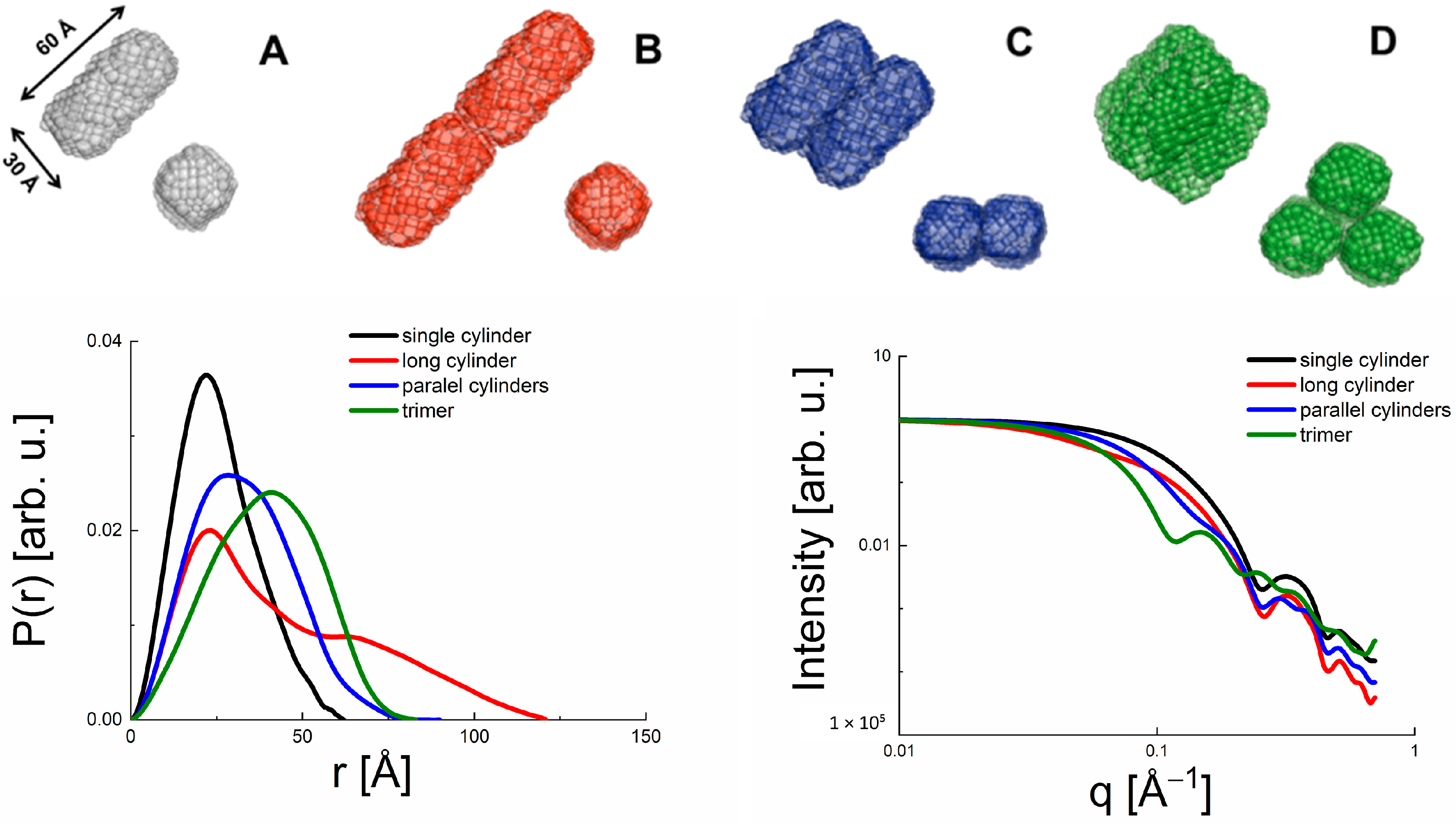
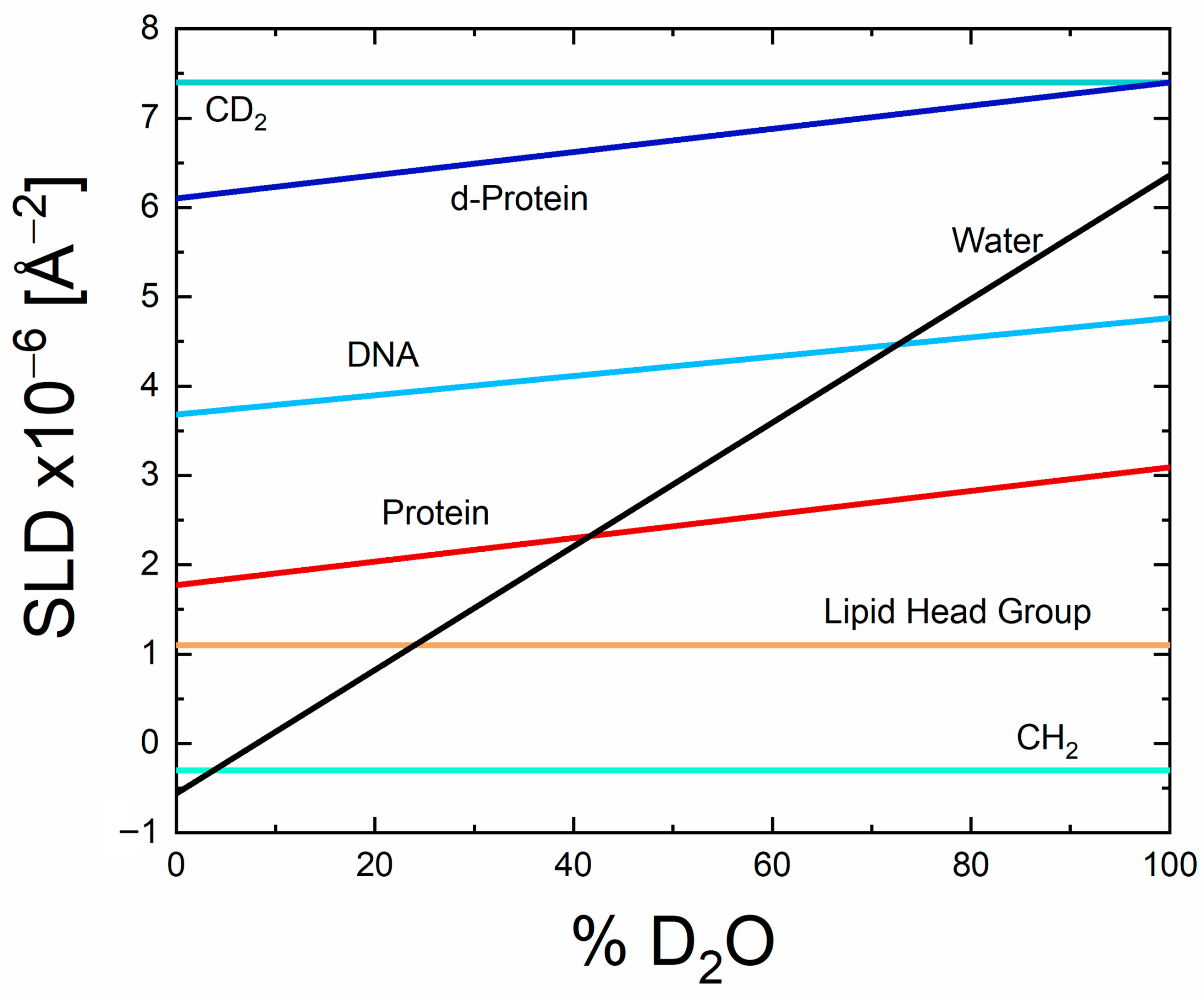
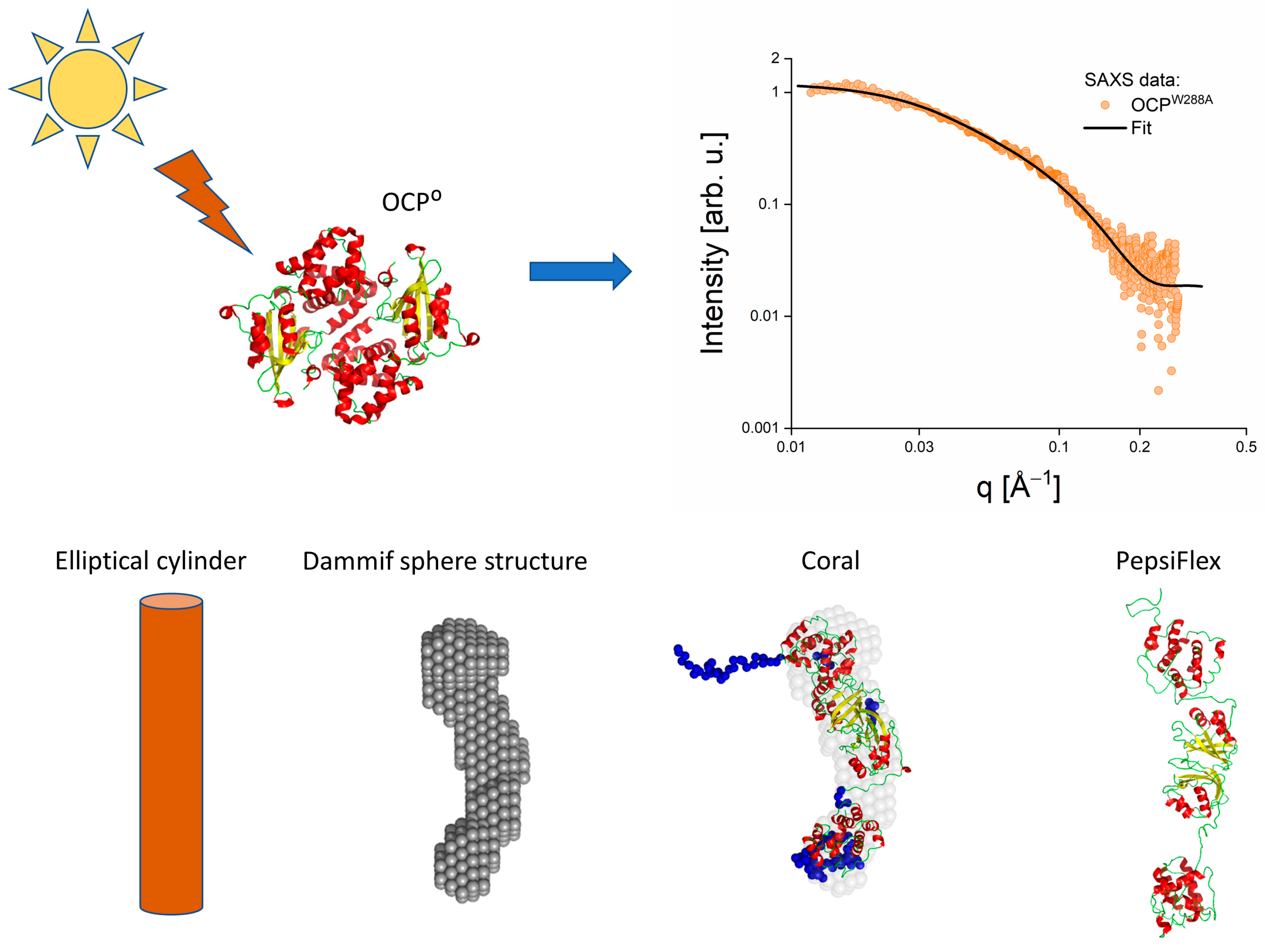

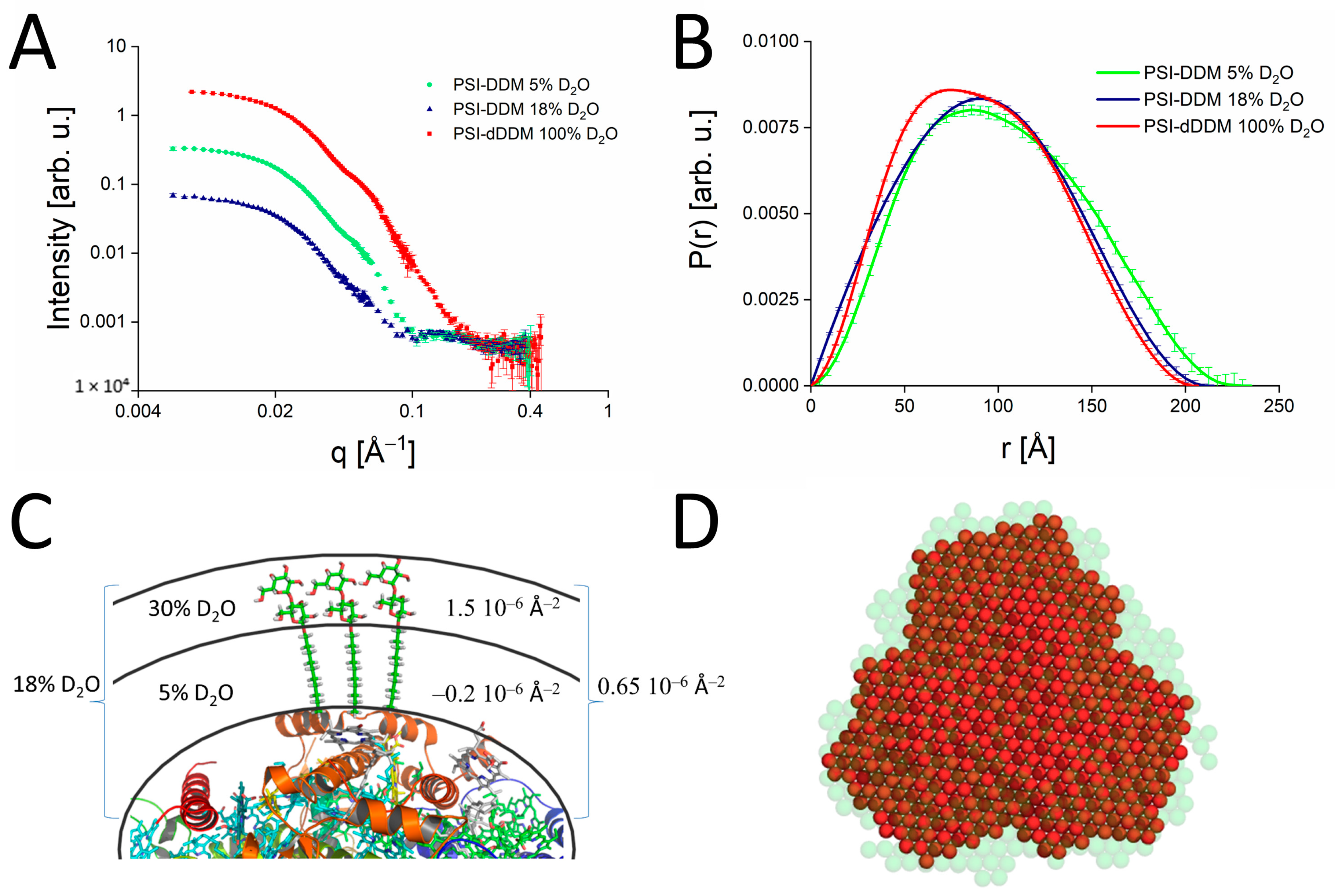
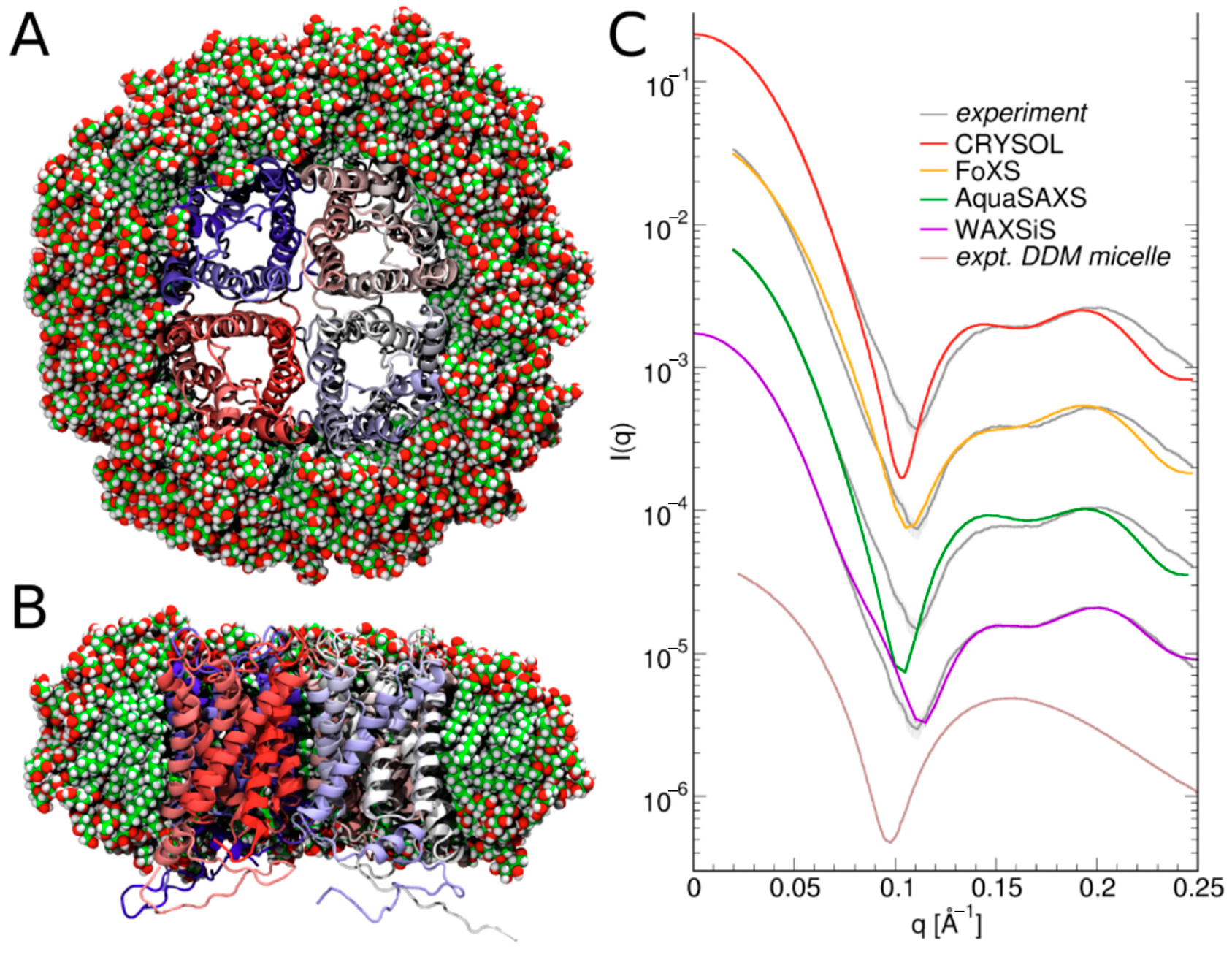
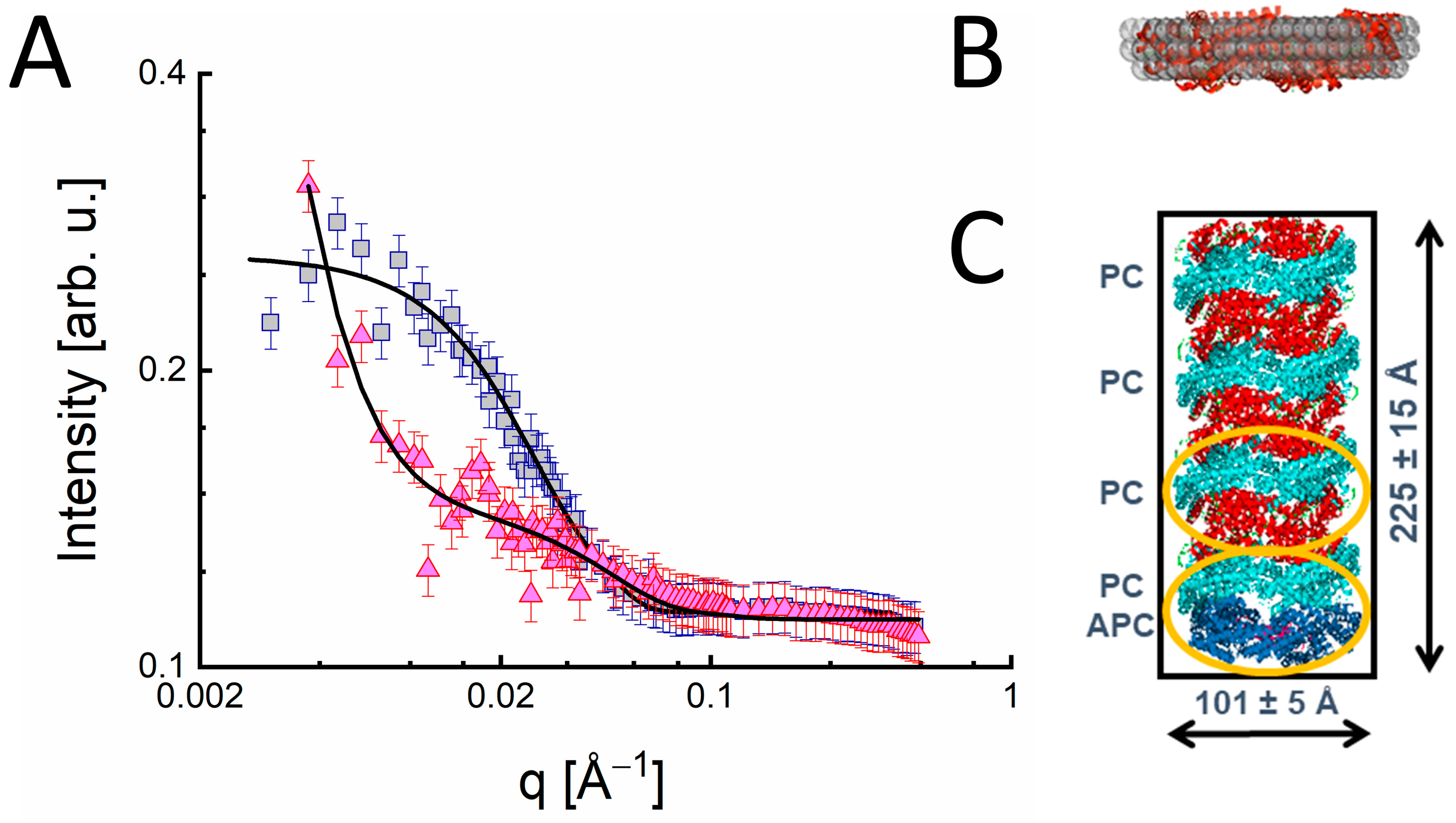
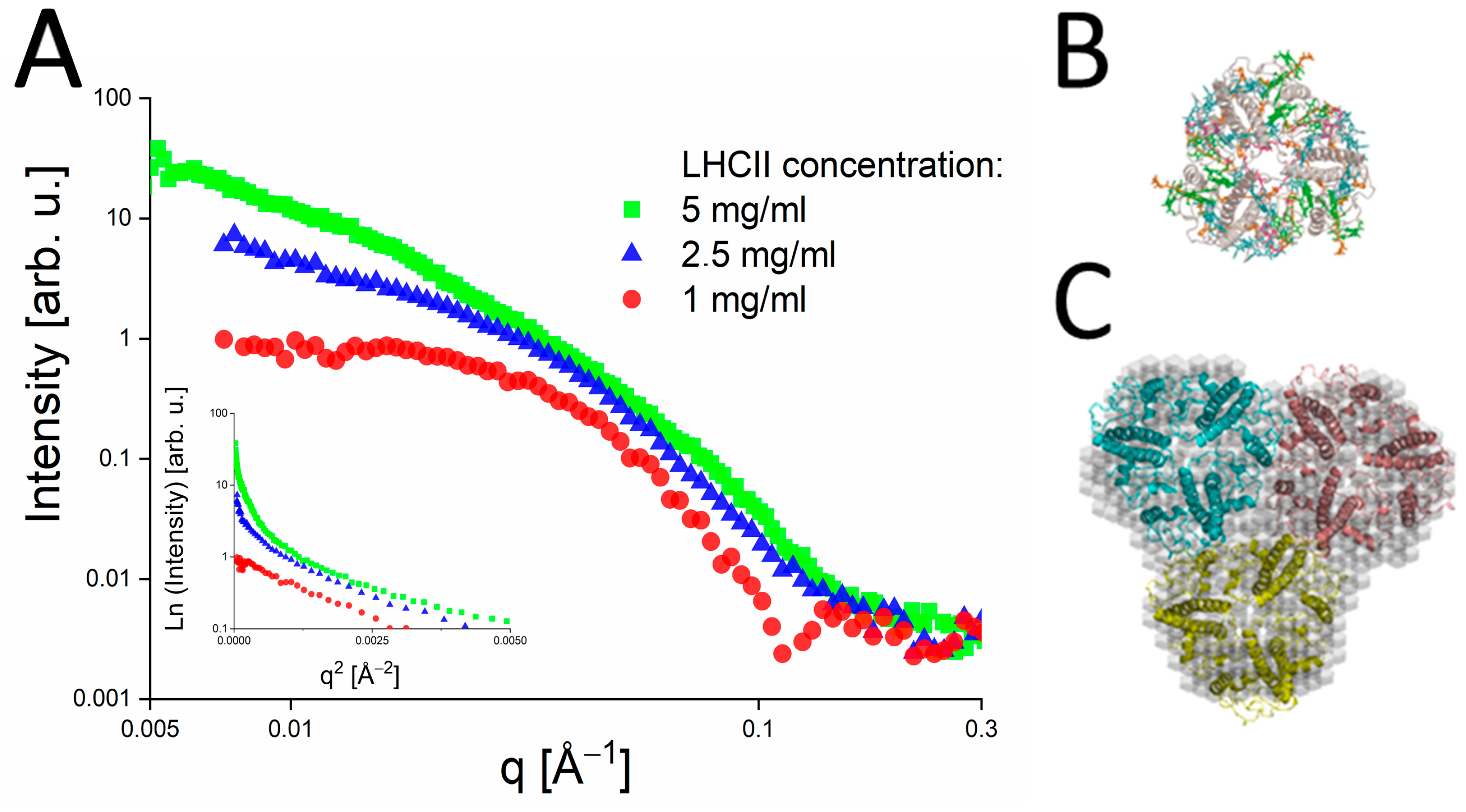
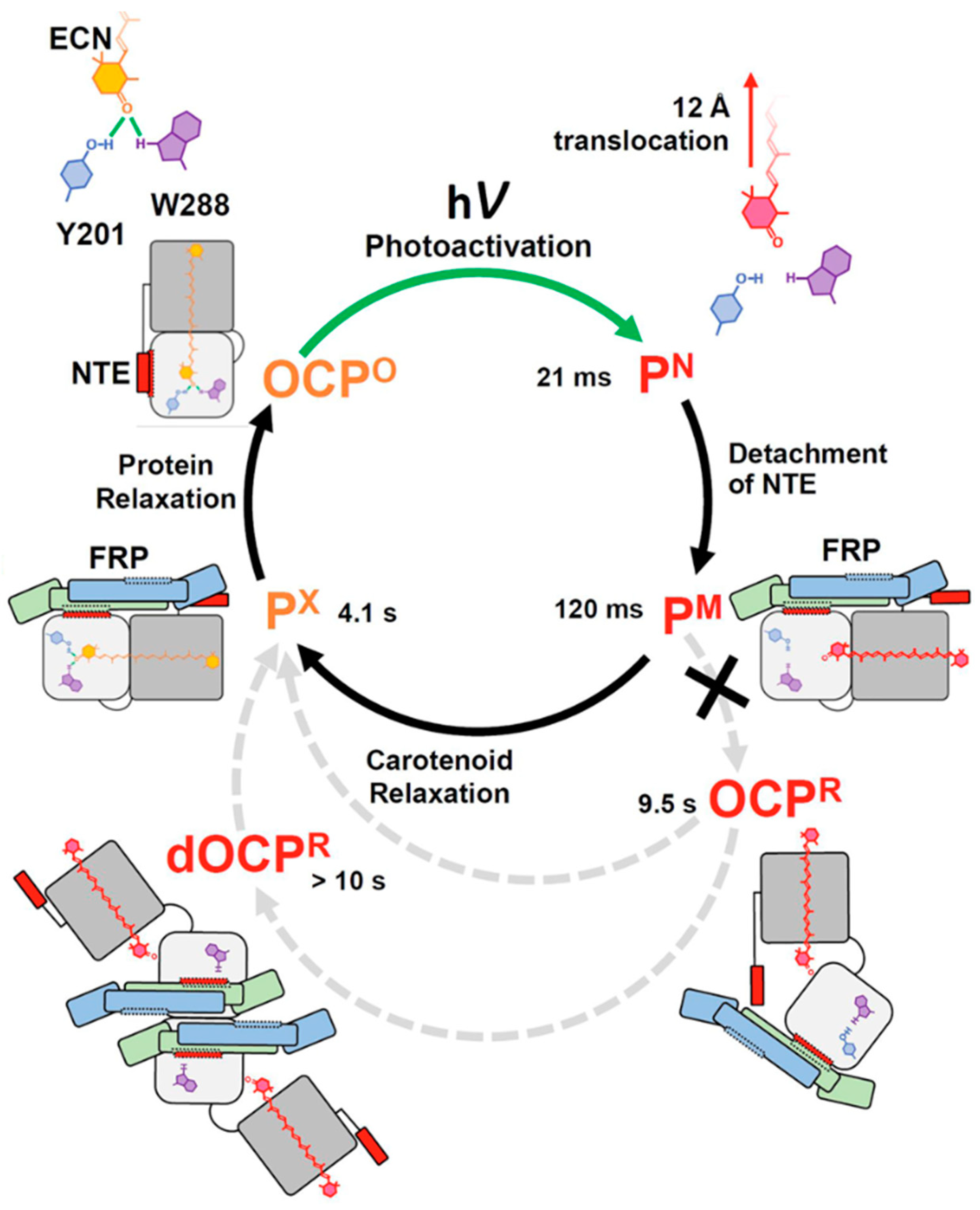
Disclaimer/Publisher’s Note: The statements, opinions and data contained in all publications are solely those of the individual author(s) and contributor(s) and not of MDPI and/or the editor(s). MDPI and/or the editor(s) disclaim responsibility for any injury to people or property resulting from any ideas, methods, instructions or products referred to in the content. |
© 2023 by the authors. Licensee MDPI, Basel, Switzerland. This article is an open access article distributed under the terms and conditions of the Creative Commons Attribution (CC BY) license (https://creativecommons.org/licenses/by/4.0/).
Share and Cite
Golub, M.; Pieper, J. Recent Progress in Solution Structure Studies of Photosynthetic Proteins Using Small-Angle Scattering Methods. Molecules 2023, 28, 7414. https://doi.org/10.3390/molecules28217414
Golub M, Pieper J. Recent Progress in Solution Structure Studies of Photosynthetic Proteins Using Small-Angle Scattering Methods. Molecules. 2023; 28(21):7414. https://doi.org/10.3390/molecules28217414
Chicago/Turabian StyleGolub, Maksym, and Jörg Pieper. 2023. "Recent Progress in Solution Structure Studies of Photosynthetic Proteins Using Small-Angle Scattering Methods" Molecules 28, no. 21: 7414. https://doi.org/10.3390/molecules28217414
APA StyleGolub, M., & Pieper, J. (2023). Recent Progress in Solution Structure Studies of Photosynthetic Proteins Using Small-Angle Scattering Methods. Molecules, 28(21), 7414. https://doi.org/10.3390/molecules28217414





